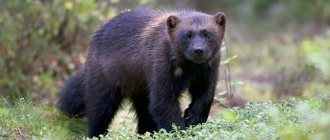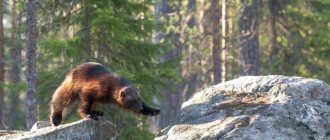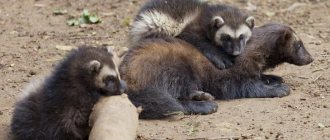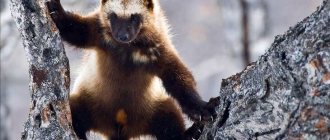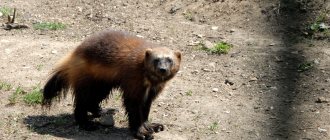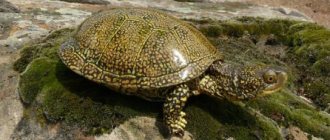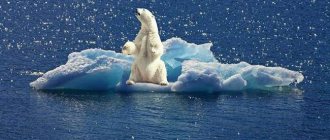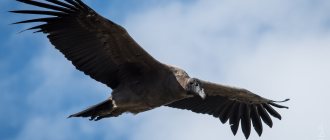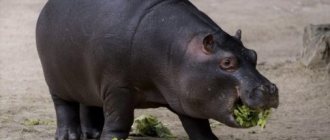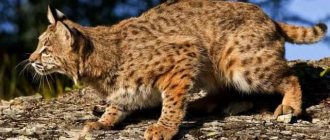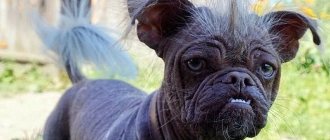The wolverine is a predatory animal from the mustelidae family; its appearance resembles a cross between a bear cub and a sable. Some Aboriginal people theorized that wolverines were actually small bear cubs that failed to grow up.
Wolverine is an interesting animal, endowed with mystical properties since ancient times. There are many legends about the beast, but not all of them are true. The Indians of North America, as well as the “forest dwellers” of the taiga areas near the Yenisei, came up with a lot of tales about wolverines.
Description and lifestyle of wolverine
Wolverines are similar to other representatives of mustelids, but they are a separate species of animal. Despite its size, the wolverine is not the largest member of the family. Giant otters rightfully occupy the leading place.
Wolverine appearance
Wolverine appearance
Wolverine appearance
Wolverine appearance
Wolverine appearance
Wolverine sizes vary from 30 to 100 cm. One tail can be up to 30 cm long. The head is small with rounded ears. Wolverines grow up to 50 cm tall with a short, dense body. Due to the widely spaced large paws, a feeling of some disproportion may be created. Despite the clumsiness of their movements, wolverines move very deftly and can easily escape from predators.
The chest can be of different shapes and is unique to each animal, just like a fingerprint. Wolverines are able to climb trees using large, strong claws. Despite this ability, animals prefer to lead a terrestrial lifestyle. They also know how to swim.
Wolverine on a tree
Wolverines can be called fearless. They can fight larger predators with their powerful jaws and sharp teeth. Animals are hardy and can run fast and for a long time without stopping. They are very strong, they can cope with a bear or a pack of wolves alone. It is for this reason that other animals prefer not to encounter them.
The fur is brown, thick and long. The animal's body is well protected from the effects of temperature. In summer, the animal sheds and short hair grows. The sides of the wolverine are decorated with stripes of predominantly white or gray colors. If the wolverine lies on the snow, it will not melt under it due to the high level of thermal insulation.
Wolverine in winter
The animal loves solitude and usually lives in areas where there are many artiodactyls. If the year turns out to be hungry, then wolverines can go far from their usual home. The animal’s home is dry and warm; the house is set up in secluded corners under tree roots and in caves. Wolverines obtain food at night and can even recapture prey from bears. Wild wolverines do not like people and avoid them.
Boar tracks
It is not difficult to distinguish the footprint of an adult wild boar from the traces of other ungulates, because in addition to the imprint of the hoof itself, a trace of stepson fingers located on the side remains on the snow or ground. It is interesting that in young piglets in the first months of life these fingers are not supporting, and therefore do not leave a mark.
Photo of wild boar tracks in the snow added by user Hanter57 in 2014.
Origin of the species
Wolverine is one of the largest predatory animals of the mustelid family. Outwardly they look like a small brown bear. Previously, scientists could not decide whether to classify wolverines as canids or weasels.
Now wolverines are considered the only representatives of their species. The animals were popularly called skunk bears because of the unpleasant odor released by the glands in case of danger. All representatives of mustelids have this means of protection.
Wolverine front view
Animals have been known since ancient times, but they are extremely difficult to study. They are not sociable and prefer to live alone. Their temperament is very fierce, wolverines are not afraid of anyone. Therefore, people preferred to avoid even casual meetings.
Animals attack livestock and can hunt adult deer. From time to time, wolverines eat prey from traps set by humans. The wolverine's appearance is deceptive; behind it lies a stern and powerful beast.
Interesting: The most dangerous insects in the country - list, names, where they are found, photos and videos
Habitat - where the wolverine lives
Habitat of the wolverine
The animals are widespread in the territories of Siberia and North America. Animals prefer forests and bushy areas. In such places there are many secluded corners where you can live peacefully. In some cases, the wolverine can be found in uncharacteristic territories, for example, in the Arctic. Animals have chosen territories where there are many other mammals, because they are the main source of food.
Wolverines live in Finland, Russia, the USA, and CIS countries. In Russia, animals prefer tundra areas. The Wolverine State (Michigan) in the USA was named so because of the large number of wolverines on its territory. Wolverines are gradually dying out; constant deforestation and fires are destroying their usual habitats.
Home range
As a rule, wolverines live alone over a very vast territory, and due to this, battles between relatives occur very rarely. Animals gather together only to mate.
Photo: Pinterest
Wolverines have large habitats. Males have a home range ranging from 600 to 1,000 square kilometers. The habitats of females range from 50 to 350 square kilometers. However, the size of the home range varies seasonally and can cover up to 2,000 square kilometers . Wolverine population densities are low due to their requirement for very large home ranges.
Males and females are territorial and do not tolerate individuals of the same sex. Territories are marked by secretions from the anal scent glands and urine. Wolverines also spray their food caches with scent gland secretions to discourage other animals from raiding them.
Appearance and features
The wolverine is second in size only to the giant sea otter, which can measure up to 1.5 meters. Female wolverines are slightly smaller, weighing up to 10 kg, while male wolverines weigh up to 15. Some individuals can weigh 20 kg. The body of the animal is up to one meter long, excluding the tail. The tail reaches 30 cm. The animal has an average height of 0.5 meters.
Wolverine is a muscular animal, with a stocky and toned body. Each paw has five toes with long and sharp claws. It is believed that there is no animal whose claws would exceed the claws of wolverines in length. Thanks to them, the animal does not have to worry about falling into the snowdrifts and not getting out. It digs well and can get through even the most inaccessible places.
Wolverine trail
The length of the hind legs creates a feeling of disproportion. The head of the beast has a slightly elongated shape. The ears are small and almost bald. On the muzzle there are miniature black eyes and a nose of the same color. The teeth are large, sharply sharpened. Thanks to them, the animal hunts excellently and can bite the bones of enemies. Even the frozen remains of animals easily succumb to the pressure of powerful jaws.
Usually the animals are dark brown or black in color, sometimes light brown individuals are found. The animal’s muzzle is decorated with a light “mask”, which can have a silver cast. Wolverines also have a lighter chest area.
Wolverine and snow
Their thick, dense coat reliably protects them from the cold in winter; they are not afraid of any obstacles. In winter they dig deep holes, large snow tunnels. This way she can get to her supplies for the winter. Animals remain in such burrows for a long time. In summer, wolverines shed a lot, and their skins are no longer so beautiful.
Interesting fact : wolverines lead a secretive lifestyle. It is not so easy to study them. Great interest in the animal arose after the release of a series of films with the main character, Wolverine. The actor was able to convey some of the animal’s habits.
How long does a wolverine live?
In the wild, wolverines stick to specific territories. They live no more than 15 years . The animals are solitary animals, so they can divide their territories only during the mating season. Usually no more than 4 puppies are born, which are cared for by the female. She fully teaches the kids and shows them how to hunt.
How long does a wolverine live in zoos?
With a lifespan of up to 15 years in the wild, the wolverine can live a couple of years longer in captivity. This is due to the fact that in zoos the animal is not in danger; it is looked after and fed.
More photos of sable tracks:
In the comments, you can share links to your photographs of winter tracks posted on the website in the gallery of hunting photos in the “Pathfinder” section.
What does a wolverine eat?
Animals prefer to eat mammals. They can hunt animals several times their own size. Wolverines are extremely resilient; they can run for hours without stopping, bringing their prey to exhaustion. They do not disdain carrion. They can be called the first forest orderlies. Even wolves don't eat that much carrion.
Interesting: Honey badger - description, habitat, what it eats, reproduction, lifestyle, photos and videos
Wolverine on the hunt
Other predators do not risk attacking wolverines. The animal is so scary when angry that it can defeat an adult bear. The animal is insatiable; they can eat more than their weight . The animals hunt artiodactyls and find carrion by the cries of ravens. Wolverines also love fruits. In the summer they sometimes drive bears out of raspberry thickets.
Mostly wolverines are solitary, but in some cases they can gather in small groups for hunting. This happens especially often near musk deer habitats. The animals are so smart that they can work together to drive the prey into a circle from which it cannot escape.
Nutrition
This predator is almost omnivorous. The main diet is ungulates. In winter, it does not disdain anything and often eats up the remains of large predators, and sometimes takes it away from smaller animals. In the spring it looks for bird nests and wasp larvae, and in warm weather it also feeds on berries. Fish, rodents, and upland game are also included in the wolverine’s diet.
The animal often drags animals caught in traps and steals food from hunters, from large predators and stores under stones or in ice crevices. In general, these animals often steal and hide everything that is in bad shape.
Features of character and lifestyle
Animals are usually solitary. They can roam from place to place and also stay in one place if there is enough food. The animals do not move very fast, but they have a lot of stamina. Sometimes an animal can travel up to 70 km without stopping for a minute. Wolverines do not allow anyone into their territories; exceptions occur only during the mating season and only for females.
Wolverine in a snow hole
Wolverines do not have a permanent place of residence. Wolverines stop to sleep in small caves, under the roots. While bearing offspring, females can build a kind of den, where they will raise their cubs for some time. Such dens are striking in their size; they can extend for several meters.
Hunting takes place at night and in the evenings. Animals do not approach people and diligently avoid them. Any competitors will be expelled from the territories.
№5
Do you think only skunks can stink? No. Wolverines too. They are often called “smelly bears.” The reason is simple. Wolverines have a special gland that secretes an unpleasant-smelling yellow liquid. Males use this liquid to mark their territory and warn other males that the territory is occupied and should be kept away from it.
Social structure and reproduction
Wolverines cannot stay with one partner their entire lives. They are accustomed to constant loneliness and meet only for mating games. The egg can only develop 7 months after fertilization. Animals allow the opposite sex to approach them only for 2 weeks, when mating games take place. The development of the egg lasts a little more than a month, after which the female gives birth. This usually happens in late winter - early spring.
wolverine cubs
Wolverines give birth to no more than four puppies. In a comfortable burrow, the female gives birth to offspring. Puppies are born very tiny - up to 100 grams. They don't see anything, with a white undercoat. Vision is gained only after a month. Up to three months, babies feed on mother's milk, and then raw meat is gradually introduced into their diet, and the mother begins to teach hunting.
By July, the cubs constantly follow their mother, observe her habits, and learn to get food. Only at the age of two years do the cubs become independent and enter adulthood.
№8
For a very long time it was believed that males do not take any part in raising their offspring. However, thanks to observations, this opinion was refuted. Observations have shown that males often visit their babies after birth, taking care of them when the mother goes hunting. They visit their offspring until they become adults and begin to hunt on their own. This happens at approximately 3 months of age.
Natural enemies
In nature, wolverines have practically no enemies. Few people dare to anger an animal; even bears avoid wolverines. This happens not only because of the ferocious disposition, but also because of the discharge with a pungent odor. Wolverines are so fearless that they take prey from wolves, lynxes and bears.
The ferocious nature of the wolverine
Lynxes are disdainful of attacking because of the pungent odor. Cats are quite clean and simply don’t want to get involved. The animals simply run away from the wolverines. At the same time, male animals can easily attack larger animals; their jaws are strong enough to bite through the bones of wolves. When wolves do not want to part with valuable prey, the wolverine begins to emit a strong odor. Wolverines are quite aggressive and scare away other animals with just their appearance.
Interesting fact : wolverines maintain the natural ecological balance of forests and water bodies. They can be considered forest orderlies, as they sometimes feed on carrion. Even wolves clear forests worse than wolverines.
At the same time, wolverines are afraid of people. They will never rush on their own; all cases of wolverines attacking people were provoked by humans . If a person approaches very close, they warn by barking, similar to a fox. An animal will not attack a person just like that out of caution. Thus, humans can be considered the most important enemy of wolverines. Poachers kill animals for their fur, which is highly prized.
Interesting: Instinct in insects
Due to human activity, the ecological situation is constantly deteriorating, and the natural habitats of wolverines are disappearing.
What does it eat?
The wolverine's diet consists of large herbivores. The prey of the beast is usually weakened or old individuals. Wolverine can also follow the tracks of a wolf pack, picking up the remains of killed deer, roe deer or elk. At the same time, she easily finds parts of carcasses hidden by wolves and hides them, including in trees.
During the warm months, most of the diet consists of carrion. In winter, especially during heavy snowfalls, the wolverine actively hunts. Due to the special structure of its paws, it easily moves through the snow, practically without falling through, while the pursued victims are exhausted quite quickly. When the snow cover is thick, an encounter with a wolverine is fatal even for large animals.
In the absence of large prey, the animal eats mouse-like rodents, birds, reptiles, and destroys nests. In summer, the diet is supplemented with nuts and berries.
It’s not for nothing that Wolverine is considered very smart. There are cases when she pulled bait from traps and traps.
Population and species status
Wolverine
Due to the extermination of animals, the number of wolverines is constantly decreasing. Extinction occurs not only due to shooting, but due to a combination of other factors. Such factors include deteriorating environmental conditions, forest fires, and the construction of new settlements. The habitat of animals is constantly decreasing, as well as their numbers.
Animals are exposed to diseases. They often suffer from rabies. The disease destroys the population very quickly and on a large scale. Wolverines become infected mainly from the corpses of animals on which they feed.
In many areas, wolverines are difficult to detect, but this does not stop poachers from constantly hunting them. The population of predators is in danger of extinction. Now the situation is stable only in North America.
Interesting fact : Wolverine fur is not particularly beautiful, but it is highly valued for its properties. In the territories of the Far North, animal fur is much more expensive than sable fur. This is due to the ability of the fur not to become covered with frost in the cold. Also, animal fur does not absorb moisture.
№11
When they are very hungry and cannot catch prey, they simply steal it. Yes, these are still those thieves. They often steal prey from predators such as bears, wolves, etc. They may boldly approach an aggressive grizzly bear and try to steal a piece of its prey. As we wrote earlier, this leads to skirmishes in which the Wolverines do not always emerge victorious.
Security
Protection of wolverines
Wolverines are recognized as a rare species, therefore they are listed not only in the Red Book of the whole world, but also in the regional Red Books of Russia:
- Red Book of the Karelian Republic;
- Red Data Book of the Murmansk Region;
- Red Book of St. Petersburg and Leningrad Region.
It should also be noted that not only animal fur is highly valued, but also live animals. It is for this reason that poachers often catch live wolverines. They are then sold to zoos who want to get such a rare and unique specimen for their collections. Due to their secretive lifestyle, wolverines cannot take root in captivity, so they are constantly nervous and experience extreme stress.
Varieties
There are two subspecies of wolverine:
- North American wolverines (Gulo gulo luscus);
- Eurasian wolverines (Gulo gulo gulo).
The differences between them appear to be largely genetic and are likely a result of the isolation of these two continental populations.
There is another possible subspecies found on Vancouver Island, Canada: Gulo gulo vancouverensis. This population has differences in skull morphology from those found on the mainland, but their status remains to be determined.
Economic importance
Thanks to their valuable and warm fur, wolverines have become the target of poachers who sell their skins on black markets. The skins are used to create collars, fur coats and hats. In severe frost, the fur is not covered with frost, which is distinctive.
Some wolverines are tamed by people and kept in their homes. Animal cubs, taken at an early age, get used to people.
How many wolverines are there in Russia?
Wolverine is very rare in nature. This happened due to the shooting of animals by poachers. Now the animals are listed in the Red Book. Despite the vast territories of Russia, no more than 10 thousand animals .
Story
Matvey Miechowski, a Polish historian of the 16th century, described the wolverine in his essay “Treatise on the Two Sarmatias”: “There is also in Lithuania and Muscovy a very voracious and useless animal, not found in other places, called the wolverine. She is the size of a dog, with a cat's muzzle, body and tail similar to a fox, black in color; feeds on carrion.
Writer Ernest Seton-Thompson (1860 – 1946) described the wolverine this way: “Imagine a weasel. Most of you have met this little beast, this destroyer, this bundle of reckless courage, this tiny killer. Now mentally magnify all this fifty times. The monster that appeared in your imagination is the wolverine.”
Wolverine in heraldry
Wolverines are actively used in heraldry as a symbol of masculinity and courage. The animals are depicted on the coats of arms of some municipalities in the northern part of the country, as well as in other habitats. Wolverine is depicted on:
- Yakut flag of Kirov nasleg.
- Norwegian coat of arms of the commune of Bardou.
- Coat of arms of Finland, US awards.
Flag of Kirov nasleg, Yakutia
Coat of arms of the municipality of Bardu (Norway)
Coat of arms of the commune of Gunnarskog (existed in 1863-1970, Sweden)
Coat of arms of Kittilä (Finland)
Coat of arms of the 337th Infantry Regiment of the United States Army (operational since 1917)
Coat of arms of the 40th Infantry Regiment of the US Army (1917-1944)
Popular message topics
- How did tea appear in Rus'?
Tea has become such a strong part of our lives that it seems that it has always been with us and it could not be otherwise. Tea actually appeared in Rus' a very long time ago, even before the British tasted it, or rather in 1567 under Ivan the Terrible. About the delicious drink - City of Irkutsk
On the land where the city of Irkutsk is now located, human settlements appeared in the Neolithic era. According to chronicles, mention of a settlement on the Irkut River occurs four times: 1620, 1652, 1656 and 1661. - Keyboard
It is impossible to imagine the modern world without a computer. Exactly the same as a computer without a keyboard. Without it, it will be impossible to enter any data, as well as fully manage the operations performed.
Scientific classification
- Domain: eukaryotes
- Kingdom: Animals
- Subkingdom: eumetazoans
- No rank: bilaterally symmetrical
- No rank: deuterostomes
- Type: chordates
- Subphylum: vertebrates
- Infratype: gnathostomes
- Superclass: quadrupeds
- Class: mammals
- Subclass: animals
- Infraclass: placental
- Superorder: Laurasiotherium
- Order: carnivores
- Suborder: Caniformes
- Family: mustelids
- Genus: Gulo Pallas
- Species: wolverine
